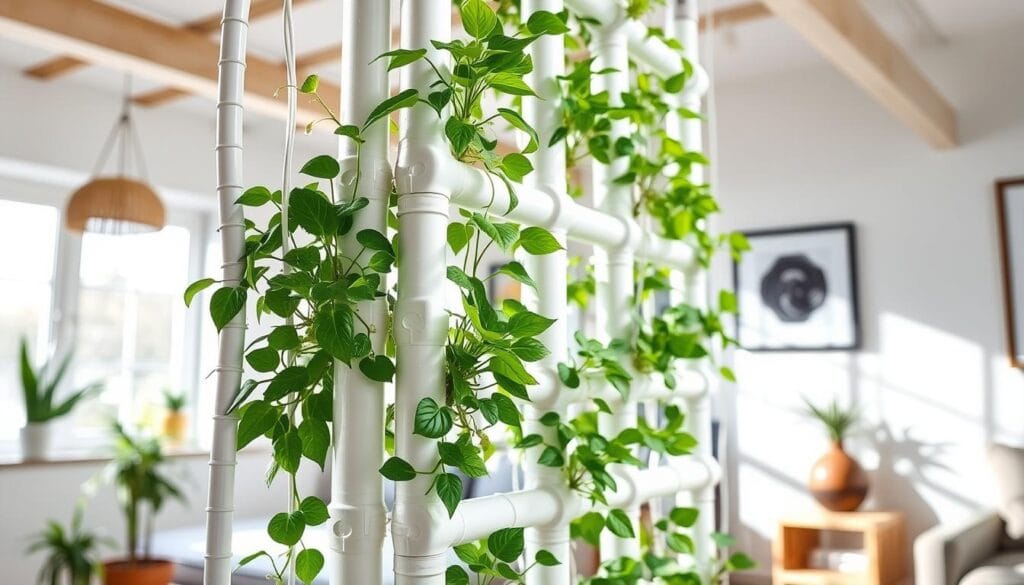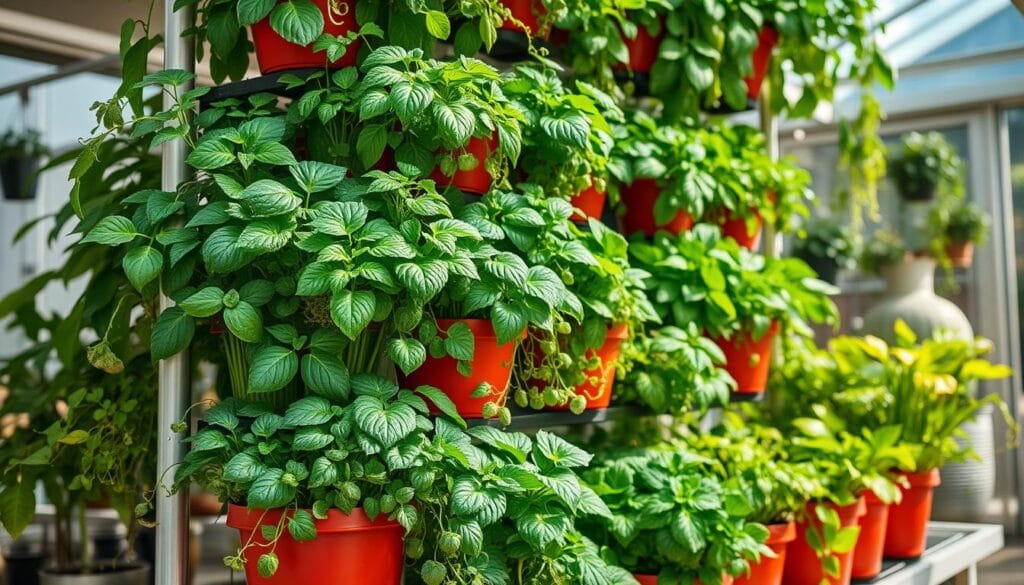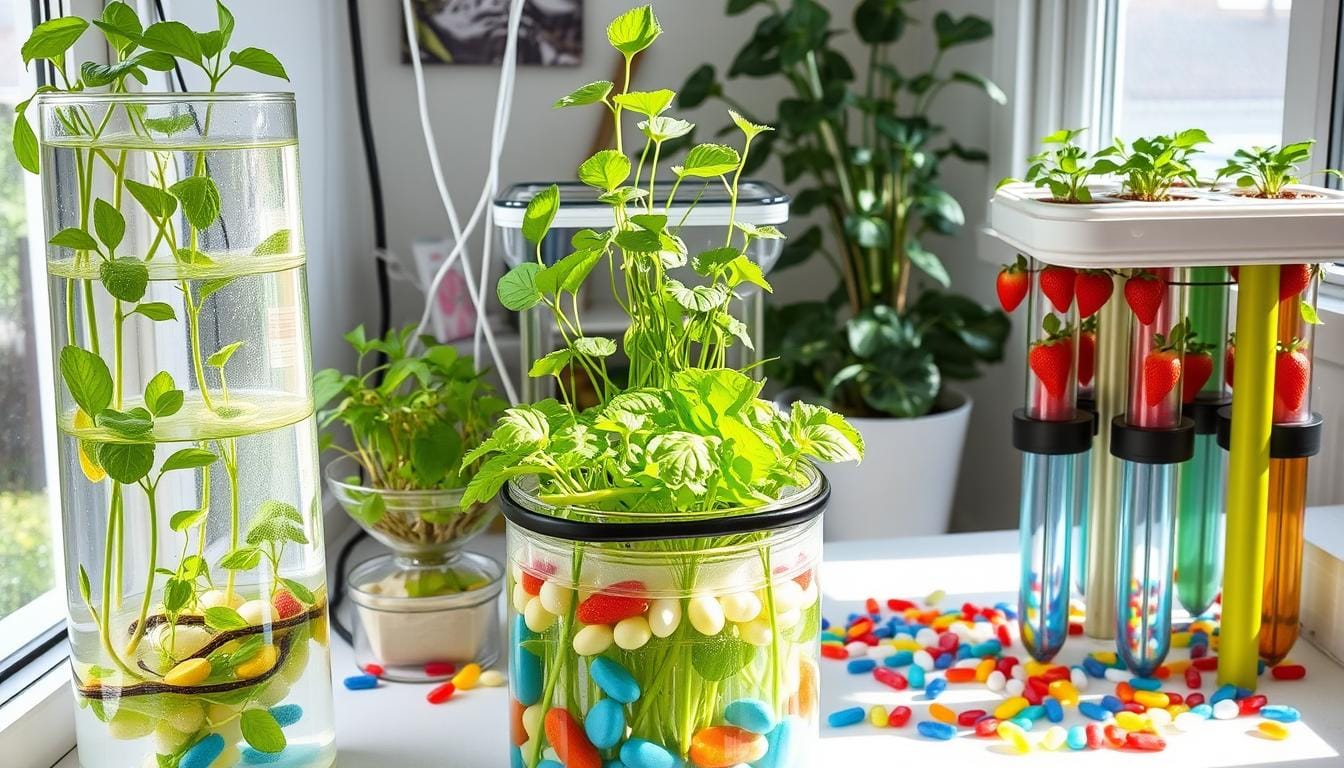DIY hydroponic ideas for your home offer a great way to grow fresh food right at your fingertips. As spring arrives, I feel a strong urge to connect with nature, and what better way to do so than by transforming my home into a green paradise? Hydroponic gardening makes this dream easy and fun. Let’s dive into 10 innovative DIY hydroponic ideas that can turn your home into a flourishing garden.
Key Takeaways
- Discover the science behind soilless growing and the essential components of a hydroponic system.
- Explore a wide range of DIY hydroponic ideas that are perfect for your home, from simple window-mounted gardens to sophisticated automated systems.
- Learn about the benefits of hydroponic cultivation, including increased yield, water conservation, and year-round access to fresh produce.
- Get inspired by eco-friendly and cost-effective indoor gardening solutions that allow you to grow your herbs, leafy greens, and even vegetables.
- Understand the importance of proper maintenance and monitoring for a thriving hydroponic garden.
Understanding Hydroponic Gardening Basics
Hydroponic gardening is a method that grows plants without soil. It uses water solutions rich in nutrients. This method is becoming popular for its benefits in sustainable agriculture.
The Science Behind Soilless Growing
Hydroponic gardening gives plants nutrients directly through water. This means no soil is needed. By controlling the water’s nutrients and pH, plants grow well.
Essential Components of a Hydroponic System
- Water: Serves as the primary medium to deliver nutrients to the plant roots.
- Nutrient Solution: A balanced blend of macronutrients (nitrogen, phosphorus, and potassium) and micronutrients essential for plant health and development.
- Grow Lights: Supplemental lighting, often LED or fluorescent, to ensure plants receive the necessary light for photosynthesis, especially in indoor or low-light environments.
- Growing Medium: Various materials like rock wool, coco coir, or perlite that support the plant roots and anchor them in the system.
- Circulation and Aeration: Pumps, tubes, and other components that ensure the nutrient solution is continuously circulated and oxygenated.
Benefits of Hydroponic Cultivation
Hydroponic gardening has many benefits. It uses less water, grows more food, and produces crops all year. It also has fewer pests and diseases. But, it needs careful setup and upkeep for success.
“Hydroponic gardening allows me to grow my own fresh produce year-round, even in my small apartment. The system is easy to maintain and I’ve been able to harvest much more than I could with potted plants.”
– Sarah, urban gardener
DIY Hydroponic Ideas for Your Home
Start growing your food with these fun DIY hydroponic ideas. Hydroponic gardening allows you to cultivate plants without the need for soil. It’s perfect for beginners and experts alike, offering a chance to explore diy hydroponics and home hydroponics systems.
Leafy greens, tomatoes, and strawberries are easy to grow in hydroponics. But, root veggies like potatoes and carrots might not do well.
For a successful hydroponic garden, watch the lighting, nutrients, and temperature. Use fluorescent lights for 15 to 20 hours a day. Keep humidity between 40% to 70% and the temperature between 65°F to 80°F.
Beginners can start with a window-mounted hydroponic garden or a vertical PVC pipe system. These are easy and affordable ways to grow your own food at home.
“Hydroponic gardening is primarily used for growing vegetables and herbs. Its benefits include larger yields, faster growth, and reduced issues with pests, diseases, or unfavorable outdoor conditions.”
For more advanced projects, try a Kratky method or a deep water culture bucket system. These DIY projects can turn your home into a garden full of fresh produce.
Remember, start small and be patient with diy hydroponics. With time and effort, you’ll enjoy the fruits of your labor in your own home garden.
Simple Window-Mounted Hydroponic Garden
If you live in the city and have little space, a window-mounted hydroponic garden is perfect. These systems are small and don’t need soil. You can grow fresh herbs, veggies, and small fruits at home, without a big backyard.
Materials and Tools Required
To start your window garden, you’ll need a few things. You’ll need a strong container, a growing medium like hydroton or coco coir, and a water reservoir. Also, get a nutrient solution made for hydroponics. A small water pump and tubing may also be necessary to transport the nutrient solution.
Step-by-Step Assembly Guide
- Choose a container that fits your window well. It could be a wide, shallow planter or a reused plastic bin.
- Put your growing medium in the container, leaving space for the plants.
- Place the water reservoir next to the planter. Use tubing along with a submersible pump to connect and circulate the nutrient solution.
- Put the nutrient solution in the reservoir, following the instructions for mixing and pH.
- Plant your DIY hydroponic crops, spacing them right for growth.
- Mount the whole thing to your window, making sure it’s level and steady.
Maintenance Tips
Keeping your hydroponic garden in check is easy. Just check the water levels and add more as needed. Keep the nutrient mix right, and watch the pH. Trim dead leaves to help plants grow well. Watch out for pests or diseases too.
With some care and the right hydroponic setup, your window garden will thrive. It will give you fresh, healthy food right at your fingertips.
Vertical PVC Pipe Hydroponic System
Make the most of your space with a DIY vertical PVC pipe hydroponic system! It lets you grow plants like lettuce, herbs, and small veggies in a small area. It’s great for homes with little room, balconies, or patios.
The system works by using vertical space. You can stack pipes to grow lots of plants in a small area. It uses closed-loop hydroponics to keep plants watered and growing fast.

- PVC pipes in various diameters (e.g., 4-inch and 2-inch)
- PVC fittings (elbows, tees, end caps)
- Water pump and tubing
- Growing medium (e.g., coco coir, perlite, or vermiculite)
- Nutrient solution
First, cut the PVC pipes to the right length. Then, make holes for planting. Use fittings to connect everything. A water pump keeps the nutrient solution circulating, ensuring a continuous supply of nutrients to your plants.
Adding a vertical PVC pipe hydroponic system to your DIY setup is smart. It lets you grow more in less space. It’s a fun way to explore new ideas in hydroponics.
Mason Jar Kratky Method Setup
The Kratky method is a simple way to grow plants without soil. It uses mason jars, making it great for DIY projects. It’s perfect for growing herbs and small greens at home.
Choosing the Right Containers
Choosing the right containers is key for the Kratky method. Wide-mouth mason jars, like 32 oz or 16 oz, are ideal. They give plants enough room to grow while keeping things compact.
You can also use net pots or make your lids. This helps support the plants and their roots.
Plant Selection for Kratky Method
The Kratky method is great for many herbs and small veggies. Basil, mint, lettuce, and cherry tomatoes are popular choices. These plants love the nutrient-rich water of the Kratky setup.
Nutrient Solution Preparation
Preparing the nutrient solution is important. Follow the supplier’s instructions to mix the right amounts. Keep the pH levels right to help plants grow well and avoid nutrient problems.
The Kratky method is easy to care for, making it perfect for beginners. It’s a great way to try passive hydroponics and DIY hydroponic ideas at home. With the right containers, plants, and nutrient solution, you can have a thriving Kratky method system.
Sustainable Hydroponic Tower Garden
Discover the power of vertical gardening and sustainable agriculture with a DIY hydroponic tower garden. These systems are perfect for growing plants like leafy greens, herbs, and small fruits at home. They conserve space and are simple to operate.
For a successful hydroponic tower garden, focus on water efficiency and recycling. A water recycling system helps reduce waste. You can build a sturdy tower with a few simple parts. It will give you a lot of plants all year long.
To start, gather materials like a tower, grow media, a water reservoir, and a pump. The best part is, you can use items like plastic bottles or PVC pipes. This makes your garden eco-friendly and fits your space.
| Vertical Gardening | Sustainable Agriculture | DIY Hydroponic Ideas |
|---|---|---|
| Saves space in small areas | Reduces water consumption | Allows for year-round growing |
| Maximizes limited square footage | Minimizes waste with recycling | Customizable to fit any space |
| Enhances visual appeal of a space | Promotes self-sufficiency | Cost-effective compared to commercial systems |
Embracing sustainable hydroponic tower gardening is good for your garden and the planet. Enjoy fresh, healthy produce from your vertical garden. It’s a win-win for you and the environment, as it promotes sustainability while also offering practical benefits for your gardening needs.

“Hydroponics can lead to plants maturing up to 25% faster and yielding up to 30% more while consuming less water compared to soil cultivation.”
Recycled Bottle Hydroponic System
Upcycling is a great way to make a green hydroponic system at home. You can turn plastic bottles into a cheap and eco-friendly setup. It’s perfect for growing herbs, leafy greens, and small plants.
Upcycling Materials
To make a recycled bottle hydroponic system, you need the right stuff. Here’s what you’ll need:
- 16-20 oz plastic bottles or 1-liter bottles
- Scissors or a sharp knife for cutting the bottles
- Marker or pen for marking the bottles
- Awl or drill for creating holes
- Perlite or other growing media
- Water-resistant tape
- Cotton yarn or wick material
- Nutrient solution and liquid fertilizer
System Assembly Instructions
After getting your materials, follow these steps to build your system:
- Cut the top off the plastic bottle, leaving 4-6 inches.
- Drill or poke a small hole in the bottle cap or lid.
- Thread a piece of cotton yarn or wick material through the hole in the cap. Ensure the tubing is long enough to reach the bottom of the container.
- Fill the bottom part of the bottle with perlite or your chosen growing medium.
- Put your plant sapling or seed in the perlite, making sure it’s secure.
- Pour nutrient solution into the bottle, but don’t overdo it.
- Reattach the cap with the wick to the bottle. This makes a self-watering system.
This DIY method lets you make a small but effective hydroponic system at home. It uses upcycled materials and sustainable hydroponics ideas.
“Upcycling offers a creative and sustainable way to build a hydroponic system for your home.”
Smart Automated Hydroponic Cabinet
The future of indoor gardening is here with smart automated hydroponic cabinets. These systems use technology to make caring for plants easy. They are ideal for anyone looking to grow their own food at home.
These cabinets have advanced features for growing herbs, veggies, or smart hydroponics. They have programmable lights, automated nutrient systems, and remote monitoring. This means your plants get the care they need without you having to do it all.
If you like to DIY, you can build your own smart hydroponic cabinet. You can use microcontrollers, sensors, and grow lights. This way, you can make the system fit your needs and create a personalized growing space.
Using these automated growing systems has many benefits. They save time and effort, and they give you consistent results. With just a few minutes of care each week, you can have a big harvest at home.
“The Hey abby OG marijuana grow kit can potentially harvest up to 8oz of dry flower from each 3-month growth cycle.”
Whether you’re new to gardening or have been doing it for years, a smart automated hydroponic cabinet is a game-changer. It lets you make the most of your indoor space and take your smart hydroponics to the next level.
Deep Water Culture Bucket System
Looking into hydroponic gardening? The deep water culture (DWC) bucket system is a great DIY choice. It keeps plant roots in nutrient-rich water. This method boosts oxygen and nutrient uptake for quicker growth.
Equipment List
- Food-grade plastic bucket (3.5 gallons or 13 liters)
- Air pump and air stone
- Net pot or mesh basket (10-inch or 25 cm diameter)
- Growing media like rock wool or clay pellets
- Hydroponic nutrient solution
Building Process Overview
Setting up a DIY deep water culture system is easy. Start by drilling a hole in the bucket lid for the net pot. Next, connect the air pump to the air stone and put it at the bucket’s bottom. Fill the bucket with nutrient solution, leaving space at the top.
Finally, add the net pot with growing media and your plants. Your DWC system is now ready for a hydroponic harvest!
Deep water culture is perfect for big plants like tomatoes, peppers, and leafy greens. It offers constant oxygen and nutrients for fast, healthy growth. This DIY hydroponic setup is great for both new and seasoned gardeners. It’s a fantastic way to enjoy the perks of home hydroponics systems.
Indoor Hydroponic Herb Wall
Take your home cooking to the next level with an indoor hydroponic herb wall. This smart vertical garden looks great and works well. It allows you to grow fresh herbs right in the comfort of your home. Use pocket planters or custom frames with water systems to save space and grow herbs all year.
An indoor hydroponic herb wall is super flexible. It fits any home, big or small. You can grow many herbs like basil, mint, thyme, and rosemary. This way, you don’t lose valuable floor space.
To make your own indoor hydroponic herb wall, add good lighting and a drip irrigation system. This makes caring for your herbs easy. With the right light and water, your herbs will grow well. You’ll always have fresh herbs for your cooking.
Vertical gardening turns a blank wall into something lively and useful. With careful planning, your herb wall will be a beautiful kitchen feature. It will also impress your visitors.
Whether you’re new to gardening or have experience, an indoor hydroponic herb wall is rewarding. It lets you use your space better and enjoy fresh herbs easily.
Conclusion
The world of DIY hydroponics is full of possibilities for home gardeners. It offers sustainable, space-saving solutions. You can find everything from simple setups to advanced systems, fitting all skill levels and homes.
DIY hydroponics lets you grow fresh produce all year round. This promotes a healthier lifestyle and helps the environment. It’s ideal for both beginners and experienced gardeners.
With DIY hydroponics, you can grow a wide range of plants. This includes leafy greens, herbs, fruits, and vegetables. It uses soilless cultivation, which means you can control growth, save space, and use less water.
When looking into DIY hydroponics, think about your space, the plants you want, and your gardening goals. With the right setup and effort, you can have a sustainable harvest at home. This leads to a greener, more self-sufficient future.

